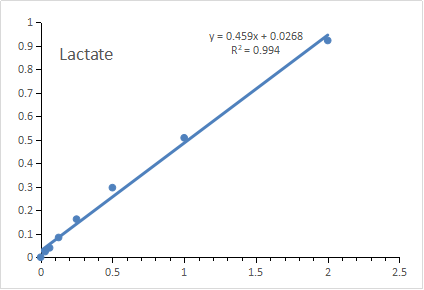| Product name | CheKine™ Micro Lactate Assay Kit |
| Applications notes | CheKine™ Micro Lactate Assay Kit provides a convenient means for detecting L (+) -Lactate in biological samples such as in serum or plasma, cells, culture and fermentation media. In this kit lactate is oxidized by lactate dehydrogenase to generate a product which interacts with a tetrazolium salt WST-8 dye to form a colorimetric (450 nm) product, proportional to the lactate present. |
| Kit components | • Lactate Assay Buffer • Lactate Dehydrogenase • Lactate Dehydrogenase Cofactor • WST-8 • Enhancer • L (+) -Lactate Standard (100 mM) |
| Features & Benefits | • Determination of L (+) -Lactate in serum, plasma, cell/tissue samples, plant tissues,urine and other biological fluids. • Detect biological samples at a level of 0.03 mM-2 mM. • Pre-treatment or purification of samples are not required. • Using WST-8 as substrate, more sensitive than MTT. |
| Usage notes | • If not assayed immediately, samples can be stored at -80°C for one month. • It is recommended to perform several dilutions of your sample to ensure the readings are within the standard value range. • Fresh samples are necessary for good results. If don't perform the assay at the same time, it's better to complete the Sample Preparation step before storing the samples. |
| Storage instructions | Storage at -20°C and Keep from light immediately upon receipt. Kit has a storage time of 6 months from receipt. Refer to list of materials supplied for storage conditions of individual components. |
| Shipping | Gel pack with blue ice. |
| Precautions | The product listed herein is for research use only and is not intended for use in human or clinical diagnosis. Suggested applications of our products are not recommendations to use our products in violation of any patent or as a license. We cannot be responsible for patent infringements or other violations that may occur with the use of this product. |
| Background | Lactate is an important intermediate product in the metabolic process of organisms, which is closely related to glucose metabolism, lipid metabolism, protein metabolism and intracellular energy metabolism. The content of lactate is an important indicator to evaluate glycogen metabolism and aerobic metabolism. |

Fig. Standard Curve of Lactate assay. The y-axis is OD450 and the x-axis is Lactate concentration (mM).
Author:Shen L, Wang J, Li Y Publication name:Molecular Biotechnology IF:112.70
Author:Zhang, Naijin, et al. Publication name:Cell Research IF:44.1
Author:J Yue, J Xu, Y Yin Publication name:International Journal of Biological Macromolecules IF:30.20
Author:Su, Zepeng, et al Publication name:Advanced Science IF:15.1
Author:Xuan L, Xu Z, Luo J, et al Publication name:Experimental & Molecular Medicine IF:12.8
Author: Wang K, Dai X, Yu A Publication name:Journal of Experimental & Clinical Cancer Research IF:12.658
Author:Chengmin Liu, Ke Jiang, Yanyan Ding, Aihua Yang, Renwei Cai, Panzhu Bai Publication name:theranostics IF:12.4
Author:Qi, Jingjing, et al. Publication name:Cell Death & Disease IF:9
Author:Chen, S., Xie, D. F., Li, S., Luo, J., Han, Y., Guo, H., ... & Zhou, P. K Publication name:Cell Death & Disease IF:9
Author:Sun H J, Zheng G L, Wang Z C Publication name:Phytomedicine IF:7.90
Author:R Zhou, RC Ding, Q Yu, CZ Qiu, HY Zhang, ZJ Yin, DL Ren Publication name:Antioxidants IF:7
Author:Wang, Xiaoyun, et al. Publication name:Ecotoxicology and Environmental Safety IF:6.8
Author:Zhang, Yaqian, et al. Publication name:Colloids and Surfaces B: Biointerfaces IF:5.8
Author:Zhou J, Mei Y K, Qian X Publication name:Colloids and Surfaces B: Biointerfaces IF:5.80
Author:Wang, Kaixuan, et al. Publication name:Frontiers in Pharmacology IF:5.6
Author:Li,Zhuo,et al. Publication name:International Journal of Oncology IF:5.2
Author:W Qiao, Y Qiao, Z Liao, G Gao, Z Wu, PEJ Saris Publication name:Int J Biol Macromol IF:5.162
Author:Dai, Qing, et al. Publication name:Frontiers in Physiology IF:4
Author:Saad AAA, Zhang F, Refat M, Mohammed EAH, Zhang M, Chen Y, Al Hamyari B, Alafifi J, Wu X, Publication name:J Pharm Biomed Anal IF:3.209
Author:Li H, Huang Q, Guo H, Chen X, Li X, Qiu M, Publication name:Thorac Cancer IF:2.9
Author:S Kyun, J Kim, D Hwang, I Jang, HY Park, K Lim Publication name:Physiological Reports IF:2.5
You must be logged in to post a review.
Reviews
There are no reviews yet.